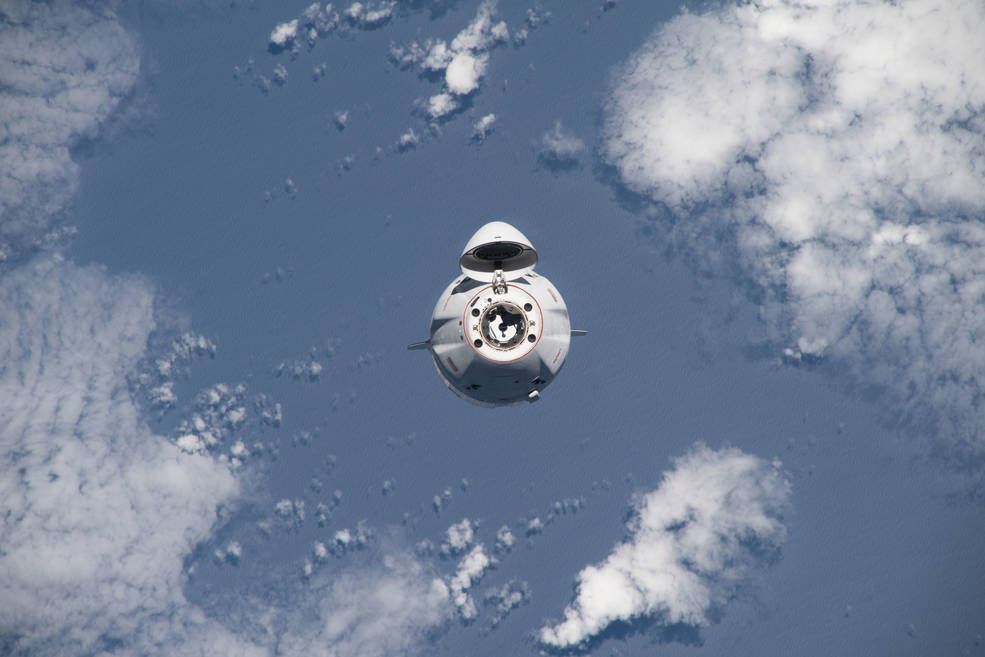
A SpaceX Dragon cargo resupply spacecraft is set to depart the International Space Station on Saturday, April 15, returning scientific research samples and hardware to Earth for NASA.
The agency will provide live coverage of Dragon’s undocking and departure starting at 10:45 a.m. EDT on NASA Television, the NASA app, and online at:
Following commands from ground controllers at SpaceX in Hawthorne, California, Dragon will undock at 11:05 a.m. from the forward port of the station’s Harmony module and fire its thrusters to move a safe distance away from the station.
After re-entering Earth’s atmosphere, the spacecraft will make a parachute-assisted splashdown off the coast of Florida on Saturday, April 15. NASA will not broadcast the splashdown, but updates will be posted on the agency’s space station blog.
Dragon will carry back to Earth approximately 4,300 pounds of supplies and scientific experiments designed to take advantage of the space station’s microgravity environment. Splashing down off the coast of Florida enables quick transportation of the experiments to NASA’s Space Station Processing Facility at the agency’s Kennedy Space Center in Florida, allowing researchers to collect data with minimal sample exposure to Earth’s gravity.
Some of the scientific investigations that Dragon is carrying include:
- Space tomato harvest: Samples from the Pick-and-Eat Salad-Crop Productivity, Nutritional Value, and Acceptability to Supplement the International Space Station Food System (Veg-05) experiment will be returning to Earth for analysis. Astronauts grew dwarf tomatoes in the station’s Veggie miniature greenhouse and performed three harvests at 90, 97, and 104 days. They froze tomatoes, water samples, and swabs of the growth hardware to examine the effects of light quality and fertilizer on fruit production, microbial safety, and nutritional value. The ability to grow plants in space for fresh food and an improved crew living experience is important for future long-duration missions. The hardware could be adapted for use on Earth to provide fresh produce for those without access to gardens and as horticultural therapy for older people and people with disabilities.
- Growing higher quality crystals: Hicari, an investigation from JAXA (Japan Aerospace Exploration Agency), tested a growth method and produced crystals of a silicon-germanium (SiGe) semiconductor using the Japanese Experiment Module-Gradient Heating Furnace (JEM-GHF). This crystal growth method could support development of more efficient solar cells and semiconductor-based electronics. The space-produced crystals are returning to Earth for analysis.
- Analyzing aging arteries: Astronauts can experience accelerated arterial wall stiffening and thickening after six months in space, and a daily session of aerobic exercise alone may not be sufficient to counteract these effects. Vascular Aging, an investigation from CSA (Canadian Space Agency), monitors these changes using artery ultrasounds, blood samples, glucose tolerance tests, and wearable sensors. Results could help identify and assess risk to astronaut cardiovascular health and point to mechanisms for reducing that risk. For the aging population on Earth, understanding the mechanisms behind arterial stiffness could provide insight to guide prevention and treatment. Blood samples collected for the investigation are returning to Earth for analysis.
- Fire safety: Solid Fuel Ignition and Extinction – Growth and Extinction Limit (SoFIE-Gel) studies burning in microgravity, including how fuel temperature affects material flammability. The investigation could improve safety of crew members on future missions by increasing understanding of early fire growth behavior, informing selection of fire-resistant spacecraft cabin materials, validating flammability models, and helping to determine optimal fire suppression techniques. Studying flames in space without the complications of buoyancy also helps improve computer models of combustion for terrestrial applications. Gel samples from the investigation are returning to Earth for further analysis.
Dragon arrived at the space station March 16 as SpaceX’s 27th Commercial Resupply Services mission for NASA, delivering more than 6,000 pounds of research investigations, crew supplies, and station hardware. It was launched March 14 on a SpaceX Falcon 9 rocket from Launch Complex 39A at Kennedy.
-end-
Lora Bleacher
Headquarters, Washington
202-358-1100
lora.v.bleacher@nasa.gov
Sandra Jones
Johnson Space Center, Houston
281-483-5111
sandra.p.jones@nasa.gov
Lora Bleacher
Headquarters, Washington
202-358-1100
lora.v.bleacher@nasa.gov
Sandra Jones
Johnson Space Center, Houston
281-483-5111
sandra.p.jones@nasa.gov

























